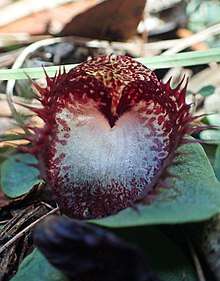Corybas hispidus
| Bristly helmet orchid | |
|---|---|
 | |
| Corybas hispidus near Ebor | |
| Scientific classification | |
| Kingdom: | Plantae |
| (unranked): | Angiosperms |
| (unranked): | Monocots |
| Order: | Asparagales |
| Family: | Orchidaceae |
| Subfamily: | Orchidoideae |
| Tribe: | Diurideae |
| Subtribe: | Acianthinae |
| Genus: | Corybas |
| Species: | C. hispidus |
| Binomial name | |
| Corybas hispidus | |
| Synonyms[1] | |
|
| |
Corybas hispidus, commonly known as the bristly helmet orchid, is a species of orchid endemic to eastern Australia. It is distinguished from other helmet orchids by its autumn to winter flowering period, and by its labellum which has a bristly-hairy, creamy-white centre and is deeply notched along its top edge.
Description
Corybas hispidus is a terrestrial, perennial, deciduous, herb with an underground tuber. It has a single dark green leaf which is more or less circular in shape, 15–35 mm long and wide and silvery-green or reddish on the lower surface. The single flower is reddish-purple and white with a greenish-grey dorsal sepal with red or dark purple spots. The dorsal sepal is egg-shaped or spoon-shaped, forms a hood over the labellum and is 22–36 mm long and 11–18 mm wide when flattened. The lateral sepals are linear in shape, 5–9 mm long and about 1 mm wide. The petals are about 5mm long and 1 mm wide, linear in shape except for near their base which is wing-shaped. The labellum is tube-shaped, 20–30 mm long and wide and the edges have many linear teeth. The central "boss" of the labellum is dome-shaped and white with a notch at the top and the surface is covered with short, stiff bristles. Flowering is from March to August.[2][3][4]
Taxonomy and naming
Corybas hispidus was first formally described in 1973 by David Jones from a specimen found near the village of Wulgulmerang. The description was published in "The Victorian Naturalist".[1] It was the first of many orchids described by Jones.[5] The specific epithet (hispidus) is a Latin word meaning "bristly", "rough", "hairy" or "prickly".[6]
Distribution and habitat
Bristly helmet orchid occurs in south-east Queensland, on the ranges and tablelands of New South Wales and in sheltered sites in far north-eastern Victoria.[2][3][4][7]
References
- 1 2 3 "Corybas hispidus". APNI. Retrieved 27 April 2017.
- 1 2 Jones, David L. (2006). A complete guide to native orchids of Australia including the island territories. Frenchs Forest, N.S.W.: New Holland. p. 171. ISBN 1877069124.
- 1 2 Jeanes, Jeff. "Corybas hispidus". Royal Botanic Gardens Victoris: vicflora. Retrieved 27 April 2017.
- 1 2 Jones, David L. "Corybas hispidus". Royal Botanic Garden Sydney: plantnet. Retrieved 27 April 2017.
- ↑ "Jones, David Lloyd (1944 - )". Council of the Heads of Australian Herbaria. Retrieved 27 April 2017.
- ↑ Brown, Roland Wilbur (1956). The Composition of Scientific Words. Washington, D.C.: Smithsonian Institution Press. p. 391.
- ↑ "Corybas hispidus". Atlas of Living Australia. Retrieved 27 April 2017.
External links

